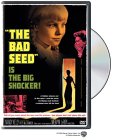Synopsis
Christine (Nancy Kelly) has a wonderful husband (William Hopper) and a perfect little girlin Rhoda (Patty McCormack). But when hubby is sent off to Washington for several weeks andChristine must hold the fort, her lovely little life cracks apart. During a school picnic, one ofRhoda’s classmates drowns. He had been the recipient of Rhoda’s anger, since he won apenmanship award she felt was rightfully hers. It doesn’t take long before Christine realizes thatthe death was not …n accident, and that she has been rearing a blond, smiling psychopath.
Taken from the play by Maxwell Anderson, The Bad Seed shows its origins likevirtually no other film on record. The actors (the play’s original cast) project their lines with suchforce that you can sometimes hear their voices echoing off the set’s walls. According to thecommentary, director Mervyn LeRoy deliberately sought this “filmed play” effect (McCormackherself points out how “big” the performances are), but the decision was a bad one. The filmis almost completely locked into a single setting (Christine’s living room), with verytheatrical entrances and exits, and the cast engaging in a top-of-the-lungs E-NUN-CI-A-TIONthat would embarrass William Shatner. Everyone’s amp is permanently set at 11, so that even themost mundane remarks (about, say, the absence of ice in a bucket) take on the dimensions oftragic opera. Somehow, McCormack and Kelly manage to push the amp a bit more in a couple ofscenes, actually hitting 12. The result, then, is a pace that is too slow, characters that grate, andsuspension of disbelief that collapses in a morass of camp. One still has to admire McCormack’schilling portrait of absolute amorality, and the ending, though obviously imposed by the censor,is pretty damn satisfying in a morbidly hilarious way.
Audio
The music of the mono track is strong and clean, sufficiently rich that one almost forgets thisisn’t stereo. There is no buzz on the dialogue, which is something of a miracle, given how thevoices are raised and how much shrieking goes on. A fine mono track, in other words.
Video
The print is in excellent shape, with nary a speckle or sign of grain. the image is sharp, andthe tones are an interestingly cold, uniform grey. The aspect ratio is the original 1.33:1 fullscreen.There are a couple of brief splices or jumps, but otherwise this is an excellent presentation of thefilm.
Special Features
Patty McCormack is interviewed for the commentary by Charles Busch, and her memories ofthe film are still very vivid, given how young she was at the time of filming. “Enfant Terrible” isanother, 15-minute, interview with McCormack, where she discusses the life of the play in moredetail than on the commentary. There is also the theatrical trailer. The menu’s main screen isscored.
Closing Thoughts
More campy than chilling today, and compromising from the full evil of the play (but thiswas 1956, after all), the film can still be enjoyed if approached in the right frame of mind.
Special Features List
- Audio Commentary
- “Enfant Terrible: A Conversation with Patty McCormack”
- Theatrical Trailer





